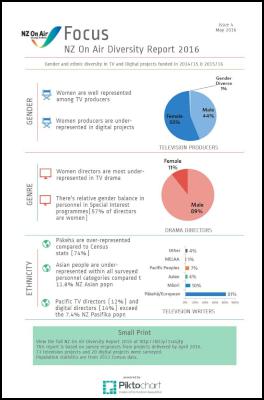New report on diversity in screen production
23 May 2016
New report on diversity in screen production highlights gaps
A report just released by NZ On Air shows gender and ethnicity gaps in some key roles in the television and digital media production sectors.
NZ On Air is launching an annual report on the gender and ethnicity make up of ‘above-the-line’ roles in screen productions funded by the agency. The first report covers the 2014/15 and 2015/16 years, for projects completed by April 2016.
The NZ On Air Diversity Report shows that women comprise 55% of funded television producers. However 33% of television directors are women, and 38% of television writers or researchers are women.
Broken down by genre women are most under-represented in drama, where they make up just 11% of all directors.
Pākehā are over-represented in all roles, compared to general population statistics, while personnel identifying as Asian are under-represented. Just 1% of television producers identify as Asian compared to 11.8% of the population at the last census.
Māori comprise 13% of television directors (a little under the census figure of 14.9%). 12 % of directors identify as Pasifika, exceeding the national population figure of 7.4%.
Trends are similar in digital media production, however there was a higher representation of Pacific people among directors at 14%, and writers/researchers at 17%.
“This is the first time we have gathered this information and it will now become an annual series so that we can monitor progress. There is clearly a challenge here which needs discussion,” said NZ On Air Chief Executive Jane Wrightson.
While NZ On Air-funded content comprises less than 15% of total television production, NZ On Air does not expect personnel data in commercially funded content to be any better.
“While we encourage the industry to take the lead in helping redress the gender and ethnicity imbalances, we will also be considering what levers we have as a funding agency,” Ms Wrightson said. “From a story-telling perspective it’s important that TV and digital media production personnel are more reflective of the general population make-up.”
The full report is available here and is summarised in the below infographic.

ENDS


 NZ Drug Foundation: Two New Studies Show A Concerning Increase In Drug Use And Availability
NZ Drug Foundation: Two New Studies Show A Concerning Increase In Drug Use And Availability Emirates Team NZ: Emirates Team New Zealand Ranked #5 In Global Sports Technology Power List
Emirates Team NZ: Emirates Team New Zealand Ranked #5 In Global Sports Technology Power List Tātaki Auckland Unlimited: Discover The Treasures Of Tāmaki Makaurau - Making Māori Tourism Accessible To All
Tātaki Auckland Unlimited: Discover The Treasures Of Tāmaki Makaurau - Making Māori Tourism Accessible To All International Writers' Workshop NZ Inc: Ōtepoti Poets Top The Kathleen Grattan Prize For A Sequence Of Poems
International Writers' Workshop NZ Inc: Ōtepoti Poets Top The Kathleen Grattan Prize For A Sequence Of Poems NZ Amateur Sport Association: 22 Amendments Proposed For 2022 Act Lodged On 22 November
NZ Amateur Sport Association: 22 Amendments Proposed For 2022 Act Lodged On 22 November Auckland University of Technology: Reading Helps Children Face A Difficult Future
Auckland University of Technology: Reading Helps Children Face A Difficult Future